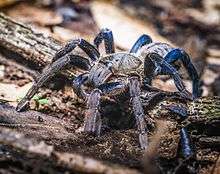Cobalt blue tarantula
The cobalt blue tarantula (Cyriopagopus lividus) is a tarantula species (family Theraphosidae) native to Myanmar[1] and over the border into Thailand.[2] It was originally described as Haplopelma lividum.
| Cobalt blue tarantula | |
|---|---|
 | |
| In Kaeng Krachan District, Phetchaburi, Thailand | |
| Scientific classification | |
| Kingdom: | Animalia |
| Phylum: | Arthropoda |
| Subphylum: | Chelicerata |
| Class: | Arachnida |
| Order: | Araneae |
| Infraorder: | Mygalomorphae |
| Family: | Theraphosidae |
| Genus: | Cyriopagopus |
| Species: | C. lividus |
| Binomial name | |
| Cyriopagopus lividus (Smith, 1996)[1] | |
| Synonyms[1] | |
| |
Description
The cobalt blue tarantula is a medium-sized tarantula with a leg span around 13 cm (5 in). It is noted for its iridescent blue legs and light gray prosoma and opisthosoma, the latter of which may contain darker gray chevrons.[3] Males and females look the same until the ultimate (final) molt of the males. At this point, the male exhibits sexual dimorphism in the form of a light tan or bronze coloration and legginess. Additionally, males gain a palpal bulb on the pedipalps and tibial apophyses (mating hooks). The female eventually becomes larger than the male and lives years longer.[4] The cobalt blue tarantula is a fossorial species and spends nearly all of its time in deep burrows of its own construction.
 A female (left) and male (right) in courtship in captivity
A female (left) and male (right) in courtship in captivity- A second-instar spiderling cobalt blue tarantula near burrow
Habitat
Cobalt blue tarantulas inhabit the tropical rainforests of Southeast Asia,[5] where they construct deep burrows, and generally only leave them to find food.
Pets
The cobalt blue tarantula is a mainstay in the pet trade, despite being a fast and defensive tarantula with potent venom.[6] Bites from this species can result in severe muscle cramps and inflammation.[7]
References
- "Taxon details Cyriopagopus lividus Smith, 1996", World Spider Catalog, Natural History Museum Bern, retrieved 2017-03-18
- "บึ้งน้ำเงินเพชฌฆาต สวยประหารพันธุ์ดุ" [The killer cobalt blue tarantula, fierce femme fatale]. Thai Rath (in Thai). 2009-05-15. Retrieved 2020-06-27.
- Photos of Haplopelma lividum
- http://www.everything-cobalt-blue.com/cobalt-blue-tarantula.html
- Smith, A. M. (1996). "A new species of Haplopelma (Araneae: Theraphosidae), with notes on two close relatives". Mygalomorph. 1: 21–32.
- Takaoka Makoto (2001). "Tarantulas Bite: Two Case Reports of Finger Bite from Haplopelma lividum". The Japanese Journal of Toxicology. 14 (3): 247–250.
- "Cobalt Blue Tarantula (Haplopelma lividum)". Keeping Exotic Pets. Retrieved 2016-04-03.
External links
| Wikimedia Commons has media related to Cyriopagopus lividus. |